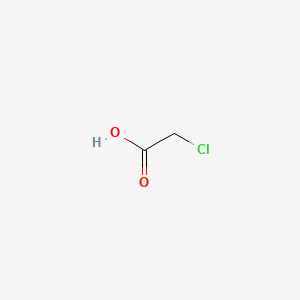| MeSH term | MeSH ID | Detail |
|---|---|---|
| Factor XIII Deficiency | D005177 | 1 associated lipids |
| Finger Injuries | D005383 | 1 associated lipids |
| Leukemia, Myelomonocytic, Chronic | D015477 | 1 associated lipids |
| Eosinophilic Granuloma | D004803 | 1 associated lipids |
| Hand Deformities, Acquired | D006227 | 1 associated lipids |
| Pulmonary Eosinophilia | D011657 | 1 associated lipids |
| Solitary Pulmonary Nodule | D003074 | 1 associated lipids |
| Giant Cell Arteritis | D013700 | 1 associated lipids |
| Leukemia, Mast-Cell | D007946 | 1 associated lipids |
| Hemangioendothelioma | D006390 | 1 associated lipids |
2-chloro-acetic acid
2-chloro-acetic acid is a lipid of Fatty Acyls (FA) class.
Cross Reference
There are no associated biomedical information in the current reference collection.
Current reference collection contains 1900 references associated with 2-chloro-acetic acid in LipidPedia. Due to lack of full text of references or no associated biomedical terms are recognized in our current text-mining method, we cannot extract any biomedical terms related to diseases, pathways, locations, functions, genes, lipids, and animal models from the associated reference collection.
Users can download the reference list at the bottom of this page and read the reference manually to find out biomedical information.
Here are additional resources we collected from PubChem and MeSH for 2-chloro-acetic acid
Possible diseases from mapped MeSH terms on references
We collected disease MeSH terms mapped to the references associated with 2-chloro-acetic acid
PubChem Biomolecular Interactions and Pathways
NCBI Entrez Crosslinks
All references with 2-chloro-acetic acid
Download all related citations| Authors | Title | Published | Journal | PubMed Link |
|---|---|---|---|---|
| Hage JC et al. | Co-metabolic degradation of chlorinated hydrocarbons by Pseudomonas sp. strain DCA1. | 2001 | Appl. Microbiol. Biotechnol. | pmid:11762603 |
| Huberman E et al. | Mutation induction in Chinese hamster V79 cells by two vinyl chloride metabolites, chloroethylene oxide and 2-chloroacetaldehyde. | 1975 | Int. J. Cancer | pmid:1176210 |
| Hefner RE et al. | Preliminary studies on the fate of inhaled vinyl chloride monomer (VCM) in rats. | 1975 | Environ. Health Perspect. | pmid:1175571 |
| Porras SP et al. | Resolution in capillary electrophoresis with nonaqueous methanol as solvent: theoretical prediction and experimental confirmation. | 2001 | Electrophoresis | pmid:11699921 |
| Dunphy CH et al. | Acute promyelocytic leukemia, hypogranular variant, with uncharacteristic staining with chloroacetate esterase. | 2001 | Leuk. Lymphoma | pmid:11699210 |
| Spahr L et al. | Rapid changes in alcoholic hepatitis histology under steroids: correlation with soluble intercellular adhesion molecule-1 in hepatic venous blood. | 2001 | J. Hepatol. | pmid:11690703 |
| pmid:11684288 | ||||
| pmid:11572590 | ||||
| Lewandowicz A et al. | Chlorine kinetic isotope effect on the fluoroacetate dehalogenase reaction. | 2001 | J. Am. Chem. Soc. | pmid:11552840 |
| Dubourg L et al. | Human kidney tubules detoxify chloroacetaldehyde, a presumed nephrotoxic metabolite of ifosfamide. | 2001 | J. Am. Soc. Nephrol. | pmid:11461933 |
| Huynh R et al. | Anticoagulant properties of dextranmethylcarboxylate benzylamide sulfate (DMCBSu); a new generation of bioactive functionalized dextran. | 2001 | Carbohydr. Res. | pmid:11403090 |
| pmid:11377679 | ||||
| pmid:11377678 | ||||
| pmid:11344393 | ||||
| Klobusická M | Reliability and limitations of cytochemistry in diagnosis of acute myeloid leukemia. Minireview. | 2000 | Neoplasma | pmid:11263855 |
| Urbansky ET et al. | Ascorbic acid reduction of residual active chlorine in potable water prior to halocarboxylate determination. | 2000 | J Environ Monit | pmid:11256708 |
| pmid:11202178 | ||||
| Rozman KK and Doull J | The role of time as a quantifiable variable of toxicity and the experimental conditions when Haber's c x t product can be observed: implications for therapeutics. | 2001 | J. Pharmacol. Exp. Ther. | pmid:11181890 |
| Saghir SA et al. | Kinetics of monochloroacetic acid in adult male rats after intravenous injection of a subtoxic and a toxic dose. | 2001 | J. Pharmacol. Exp. Ther. | pmid:11160650 |
| Donnelly PS et al. | Carboxymethylation of cage amines: control of alkylation by metal ion coordination. | 2000 | Inorg Chem | pmid:11151385 |
